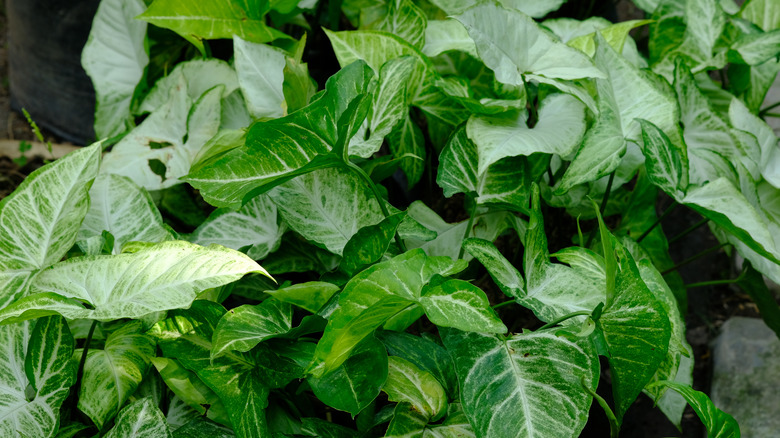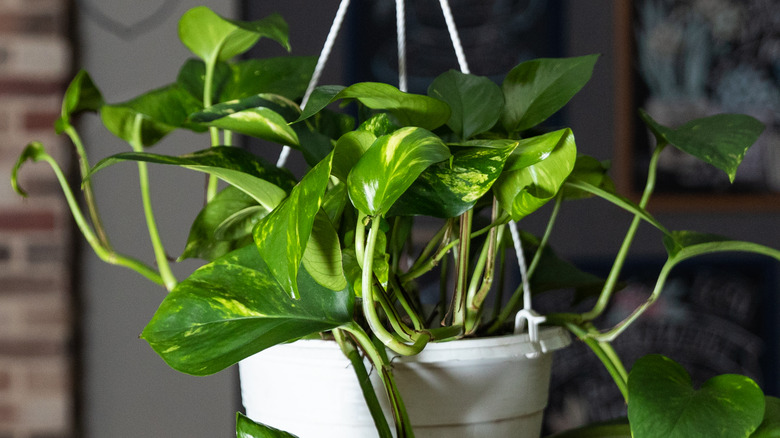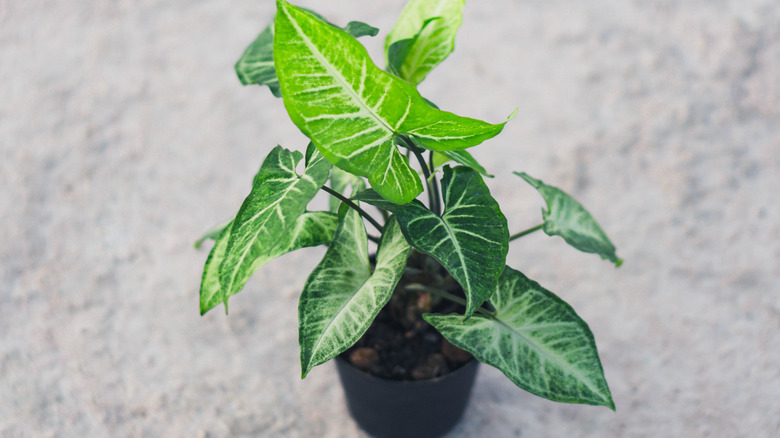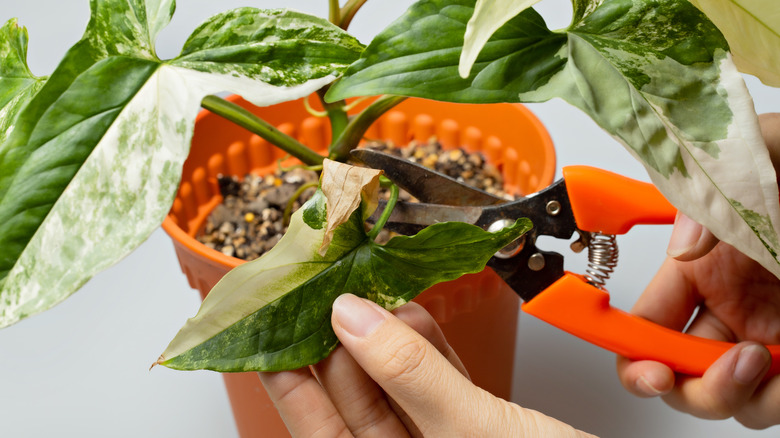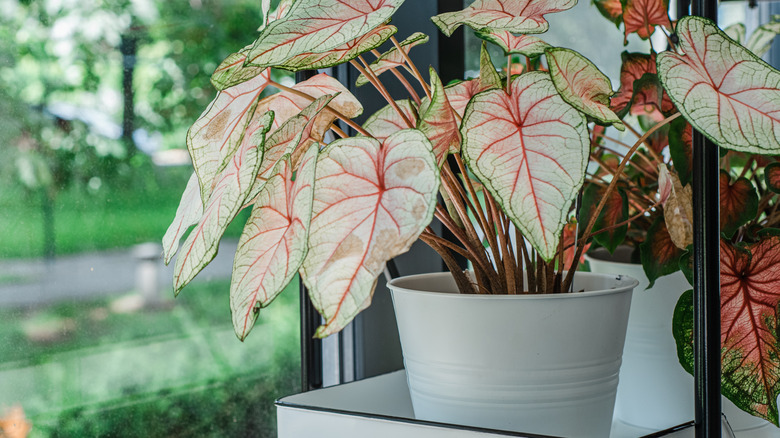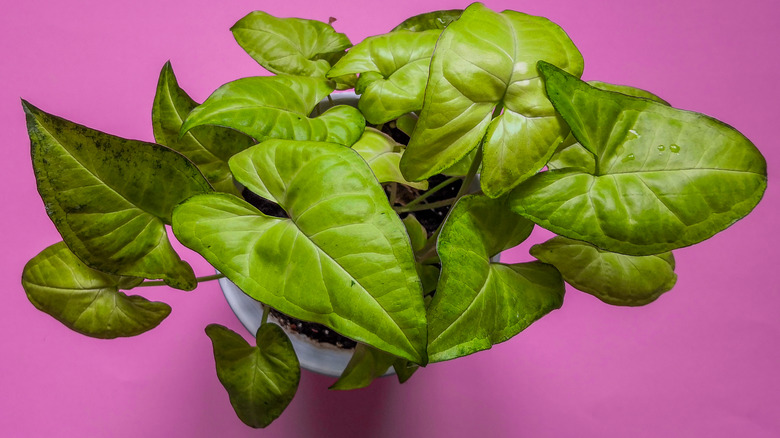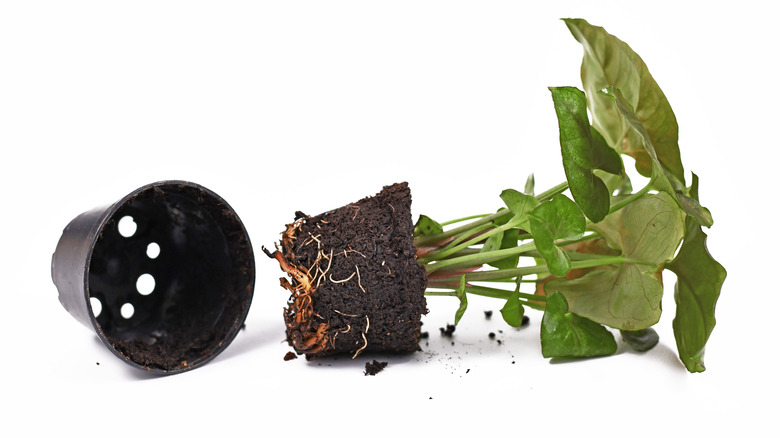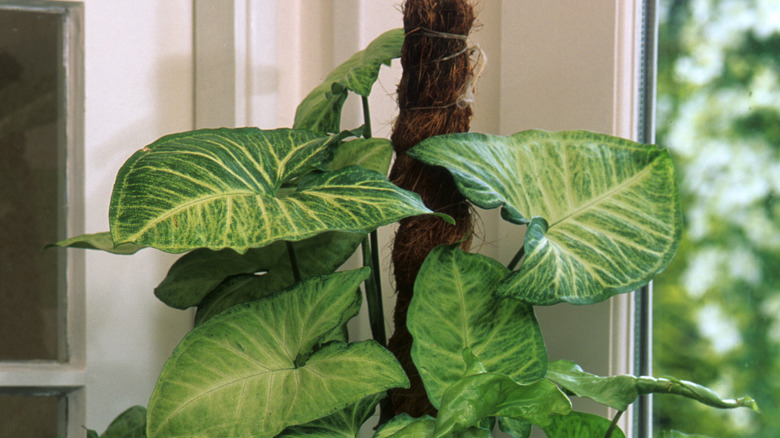Arrowhead Plant: Everything You Need To Know Before Planting
The Syngonium podophyllum, most commonly known as the Arrowhead plant or Arrowhead vine, is one of the easiest houseplants to grow and care for. It's also one of the most versatile considering the interesting shape, the two-toned green leaves, and the fact that it climbs as it grows and can be woven along a trellis or allowed to hang down from the sides of its planter. Likewise, it can be kept trimmed down to a bush. The leaves, which measure five to 14 inches long, start off with duo shades of green and silver, and their coloring turns a more solid green as they mature, per Missouri Botanical Garden's page.
Additionally, the Arrowhead serves as inspiration for Feng Shui aficionados who are looking to incorporate its graceful shape and positive energy into their décor, explains Rolling Nature. In fact, the 5-fingered shape that the leaves take on in full maturity represent the five elements of water, earth, fire, wood, and metal. Plus, they are believed to bring about peace while decreasing anxiety and stress by expanding the Chi or positive energy of a room.
Plus, the Arrowhead plant has been certified by NASA experts to have the natural ability to purify the air by increasing humidity and cutting down on microbes, which makes this plant ideal for those who are looking for a "greener" (no pun intended) way of enhancing their home environment. So, let's take a look at all aspects of caring for this sturdy, decorative houseplant.
How to use Arrowhead plant in garden
When it comes to outdoor gardening, the Arrowhead plant typically doesn't fit in well with gardens because of its rapid spread. You can probably grow it in a hanging planter or a pot on a covered porch or balcony since it doesn't require full sun exposure, but even this would not be a good idea unless you live in Florida or some other environment that's quite humid year-round. The leaves themselves love moisture, but you would need to avoid keeping the roots and stems wet.
Additionally, regarding its prolific growth, the Florida Invasive Plant Species Mobile Field Guide has noted that utilizing the Arrowhead as a trailing plant in a flowerbed wouldn't work out well since the Sunshine State has deemed it an invasive nuisance that endangers the health of surrounding vegetation. Needless to say, your best option is to keep the Arrowhead plant as an indoor houseplant in which you can maintain its short height by trimming the stems as they grow.
How to grow Arrowhead plant
The easiest way to start an Arrowhead plant involves simply buying a starter from your local nursery, though you can also purchase seeds online. However, this plant proves to be one of the easiest to propagate, and even a starter plant would spread in no time. Thus, you'll have ample opportunity to gain some cuttings. So of course, let's start with the starter plant. To properly care for your Arrowhead, you'll need a pair of gloves (because the sap can get irritating for sensitive skin), potting soil that allows for drainage, and per The Spruce, a clay or terracotta pot if your plant didn't already come with one. The reason behind this type of pot is that they wick the excess moisture out of the soil. Also, you'll need to make sure the pot has drainage holes at the bottom.
As your Arrowhead plant starts to grow and spread, propagating becomes quite simple. First off, you'll cut only the stems that contain nodes since the roots will be sprouting from these spots. Remember that each section should measure at least 6 inches, and you'll cut just below the node. Then you'll place the stems directly in a container of clean water. After a week or two, the roots will sprout, but you'll need to wait a month for the stem time to strengthen before moving the plant to a pot of soil. In the meantime, you'll top off the water periodically.
How to care for Arrowhead plant
Arrowhead plants, as mentioned in Gardening Know How, make an ideal start for the novice gardener because of their low maintenance. They don't require full sunlight, so you can place them anywhere in the house where they'll receive an average amount of indirect light.
Additionally, you can space out the number of times you water the plant long enough to allow the soil to dry. However, you can still mist the leaves with water while being careful not to keep the plant wet. The Arrowhead thrives in humidity as opposed to extremely wet areas. One way to increase the atmospheric moisture while ensuring adequate drainage is to place the pot over a tray of river pebbles. Another guarantee for a healthy plant is to keep it in humid areas of the house like the bathroom or kitchen.
In relation to fertilizer, the Arrowhead doesn't need to be fed very often, just once a month with the exception of the winter months. Plus, a liquid fertilizer usually works best.
Varieties of Arrowhead plant
The Arrowhead plant originates from the semi-tropical areas of Mexico, Brazil, Ecuador, and Bolivia where there are 30 species of this type. The most common that you'll find is the podophyllum which has 10 decorative varieties. They range in size from very compact (5 inches) to medium size (14 inches). However, in their natural habitat, they can climb up to six feet tall. Interestingly enough, many varieties also come with tinges of pink on the leaves, thus providing a more colorful option.
Here are some of the more common varieties that found in the National Gardening Association Database:
-
Cream Allusion Nephthytis — This mini relative of the Arrowhead possesses creamy green leaves with traces of pink.
-
Exotic Allusion Nephthytis — With its light green leaves that bear cream colored markings, this plant is believed to bring good luck according to the fans of feng shui.
-
Strawberry Cream — The leaves of this variety are a delicate shade of pink, making this decorative plant ideal for adding a pop of color to any space.
-
Bold Allusion Nephthytis — This slow-growing variety has creamy green leaves with pink veins and is also ideal for small spaces since it's not as prolific.
-
Julia Allusion Nephthytis — If you're looking for another unique splash of color, this variety has a pinkish, copper tinge on deep green leaves.
Whatever variety you choose, you'll still enjoy the ease of caring for this houseplant that complements any space.
Is Arrowhead plant toxic?
Unfortunately, some folks might mistake this Arrowhead for another plant by the same name: The Sagittaria cuneata, according to Go Botany, bears the same moniker and possesses some medicinal qualities. However, the Syngonium podophyllum is highly toxic to both humans and animals if ingested because of its high concentration of calcium oxalate, which can damage the kidneys and liver according to Paws Dog Daycare's blog. Therefore, if you happen to keep Arrowhead plants in your home, you'll need to be aware that they are lethal to both dogs and cats as noted in North Carolina Extension Gardener Tool Box.
Consequently, you'll need to keep these plants out of reach of animals and small children. Plus, you'll need to pick up any leaves that drop down from hanging pots. If you're not sure if your pet has eaten any part of the Arrowhead plant, then you'll need to look for symptoms such as excessive drooling, digestive issues, and vomiting. If your pet shows any of these signs, you'll need to contact your vet immediately.
How to repot Arrowhead plant
Being that the Arrowhead plant grows so rapidly, you'll need to repot it every other year if not annually. According to Joy Us Gardening, the best time to repot is during the spring or summer, or if you live in a temperate area, early fall would work.
To begin with, you'll need a pot that's at least 2 inches wider in diameter than the one you have already. Then, you'll need to follow these steps:
-
Place a coffee filter or some other biodegradable paper at the bottom of the new pot to keep the soil from running out too quickly.
-
Gently pull the root ball out of the old pot and carefully loosen up the roots.
-
Fill the new pot with the soil to where the roots sit right below the top.
-
Add more soil around the plant to give enough support to the stems.
-
From there, you can top it off with worm compost or some other fertile mix.
Right after repotting the plant, you'll need to water it thoroughly and place it where it will receive adequate light while avoiding direct sun.
How to train a climbing Arrowhead plant
Another tip to remember is if you don't want to repot your Arrowhead plant every year, you can allow the plant to grow up a moss pole. As mentioned in Gardening Know How, allowing the vine to climb along a pole would add a graceful shape, especially if you're looking to place it alongside other plants to add decoration to a corner of the room, or you can also weave it through an eye-catching trellis. Also, the Arrowhead plant, as a climber, pairs well with a red aglaonema, or you can use one of the pink varieties, like the Strawberry Cream Arrowhead vine to serve as a backdrop to some green succulents. Either way, the large, arrow-shaped leaves work well when it comes to mixing and matching colors and patterns in a small indoor or patio garden.
Otherwise, trimming the stems will help maintain a fuller yet more compact tabletop centerpiece. Whatever location you choose, the Arrowhead plant provides an enjoyable, easy-to-care-for addition to your peaceful environment.
